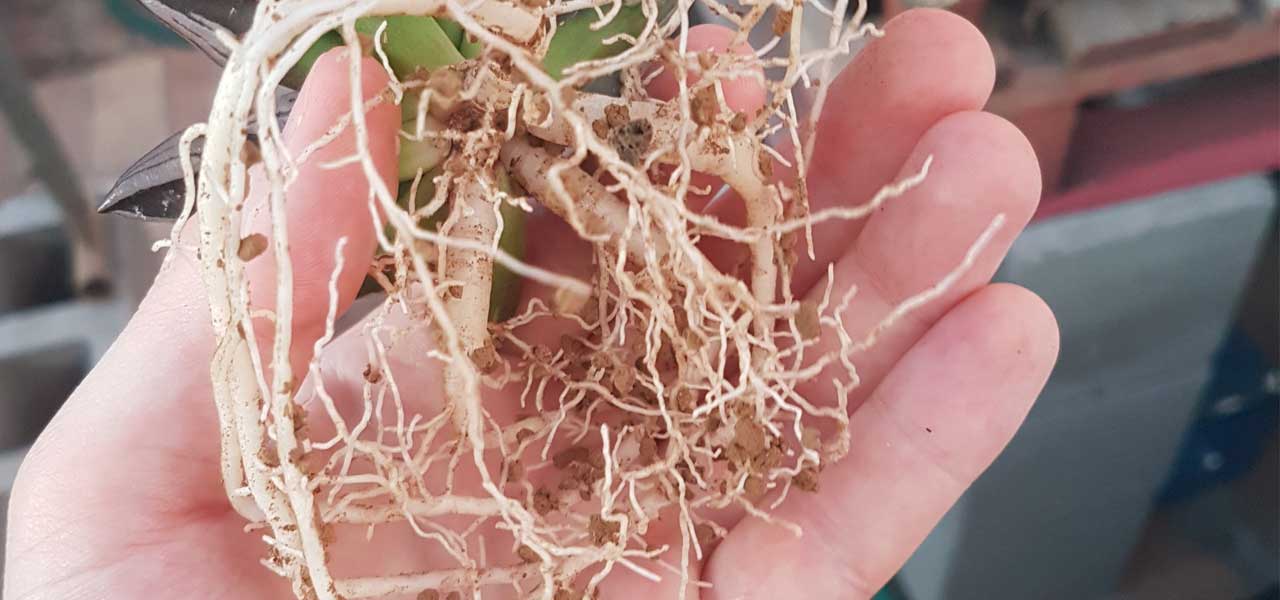spend R1000 & 2kg or less = free shipping.
spend R1000 & 2kg or less = free shipping.
bonsai
gardening
Orchids

Rooting Haworthia
5 min read
The following article was written by Harry Lewis of Living Desert Plants
In my last article, I took a few steps back from advanced Haworthia techniques, and discussed how I care for my plants in general (Read Harry's other articles here). One thing I didn’t go into detail on, that could both fit into general care or advanced techniques, is rooting Haworthia.
The best procedure to follow once you identify a plant that has had root loss is to first identify the cause of the root loss. The second stop would be to remove the cause of the root loss, and the last step would be to decide on the most suitable method and time for rooting. This article will cover these steps.
What causes a loss of roots in Haworthia?
There are several reasons why Haworthia plants would lose their roots. The main culprit is usually overwatering, as Haworthia do not like having wet feet. Their roots need to be able to breathe, which they cannot do in a constantly wet mixture.
The second reason for root loss that ties into that is an incorrect soil mixture. The more cheaply available “succulent mixes” at most nurseries are not suitable for many Haworthia. As I discussed in my general care article, Haworthia need a gritty, aerated soil mixture for their best health. In my experience, mixtures containing a high proportion of fine sand or loamy soil are not conducive to healthy Haworthia and will cause root loss over time.

Figure 1: A cored Haworthia rerooted in fine grade Ibaraki akadama
A lesser known reason for root loss is clustering, when Haworthia grow into a large clump of plants over time. The roots growing from the offsets tend to strangle the mother plant’s roots in small pots, which also prevents new roots from growing. Plants in the middle of a cluster will generally have less roots than those growing on the outer edges, as they have been in the cluster the longest and will have the hardest time getting new roots to reach soil. Haworthia also tend to drop their oldest roots after a period of time, and if these are not trimmed every few years, it can lead to the rotting of healthy roots, though again, this is only really a problem in large clusters of plants.
Disease can also cause root loss. This generally happens when a plant has damage on the roots and is then watered before it can repair the damage, as water is a perfect medium for bacteria to move through. This can be relatively easily avoided by not watering immediately after repotting a plant, as even the smallest of scrapes in a root can allow bacteria to take hold. Insects such as root mealybug feed on plant roots, but these can easily be treated with over-the-counter insecticides.
Sending a plant through a courier can also cause it to drop some, or all, of its roots, especially when packaged incorrectly. Haworthia that have been recently rooted are especially vulnerable to this, as the root has not yet been hardened. These new roots, which are white, tend to shrivel up quickly when dehydrated.
Lastly, there is intentional root removal, where the grower removes the plant’s roots. This is usually done if one is taking root or leaf propagations, or if the plant is root bound and needs some cleaning up. When coring a Haworthia, the top part of the plant will also not have any roots.

Figure 2: A Haworthia that suffered from root rot, rerooted in my general succulent mix
What are the best conditions to regrow roots on Haworthia?
Haworthia roots, in my experience, tend to detect and grow towards water, so mixtures that retain moisture without staying wet are ideal. If you want to reduce stress on the plant, use the soil mix you normally use to re-root so that you do not need to repot it later. This is, however, not strictly necessary. I prefer a mix of the fine grade Ibaraki akadama and pumice in a 50:50 ratio. The small grade is also good, but I find that fine retains moisture for slightly longer, which is useful for rooting. Both a pumice mixture and my normal succulent mixture, which consists of 1:3 LECA and 2:3 made up of equal parts of peat, pine bark and silica sand, do well for this purpose. I water my rooting Haworthia somewhat more often than normal, to make sure that there is enough moisture in the pot. Generally, this would be once per week, but do keep in mind this will fluctuate depending on another important factor in rooting, the weather.
When should I try to regrow roots on Haworthia?
Weather plays an important role in the rooting of Haworthia. Warmer weather, generally 21-29⁰C, is necessary for root development to occur at a decent pace. Anything colder than 20⁰C will not encourage root growth, and the soil mix will retain moisture for too long and could lead to rot or fungus growth. I have also noticed that in exceptionally warm weather, watering a plant in an attempt to encourage new root growth or cool it down is actually detrimental. In my experience, as I mostly use 10cm black plastic square pots, watering Haworthia at temperatures of 35⁰C or higher will cause the water to be so warm that it will “boil” the roots in the pot. This may not, however, occur in all kinds of pots or in well shaded greenhouses. To be safe, I generally do not water at temperatures higher than 30⁰C.
How to regrow roots on Haworthia
Finally, we get to the crux of the issue at hand. How do you go about growing roots on a plant that has completely lost them?
Haworthia roots grow from the “stem”. This is the brown core at the base of the plant. The core contains the meristematic cells of the plant, which is responsible for new growth. Remove all the dead root and leaf material at the base of the Haworthia, to allow more space for new roots. I tend to remove the lowest three leaves, as this exposes more surface area on the core for roots to grow from. Let plant dry for around two weeks before replanting. As you exposed some of the white core material in the stem while removing leaves, I suggest waiting one additional week after replanting before watering. This is to make sure that the scars properly callous, which prevents stem rot. When watering, let the potting mix dry out as you would with a plant that has formed roots, and do not keep it wet. I usually find using this method in South Africa, I can get new roots within 1.5-2 weeks depending on the plant. Some are, however, a bit stubborn!

Figure 3: The newly exposed core of a Haworthia with all the roots removed
Harry Lewis is a qualified nature conservationist, with a National Diploma in Nature Conservation from Cape Peninsula University of Technology, and an Advanced Diploma in the same field from the University of South Africa. Between 2015 and 2018, Harry worked with large carnivores, such as lions and leopards, but has now moved back to his hometown of Stellenbosch. He has always had a passion for everything nature, including succulents, and now runs Living Desert Plants, a small succulent nursery, from his home. He specializes in growing Haworthia, but also stocks a wide variety of mostly indigenous succulents.
Contact: Harry Lewis
0741951144
harryLivingDesert@gmail.com
www.livingdesertplants.co.za
www.facebook.com/LivingDesertPlants/
Leave a comment
Comments will be approved before showing up.
Recent Articles
-
Enthusiasts Top Wiring Tips
July 17, 2023
-
Top fertilizing tips
March 28, 2023
-
Top watering tips
February 13, 2023
-
Creating Japanese Maple forests
October 24, 2022
-
How to dig bonsai material
August 15, 2022
-
How I style bonsai and you can too
April 30, 2022
-
Swamp Cypress Bonsai Styling
July 03, 2021
-
How to hide large scars quickly
June 14, 2021
-
14 Tips for Field Growing Bonsai
May 31, 2021
-
Aquaria: An Introduction
January 06, 2021





